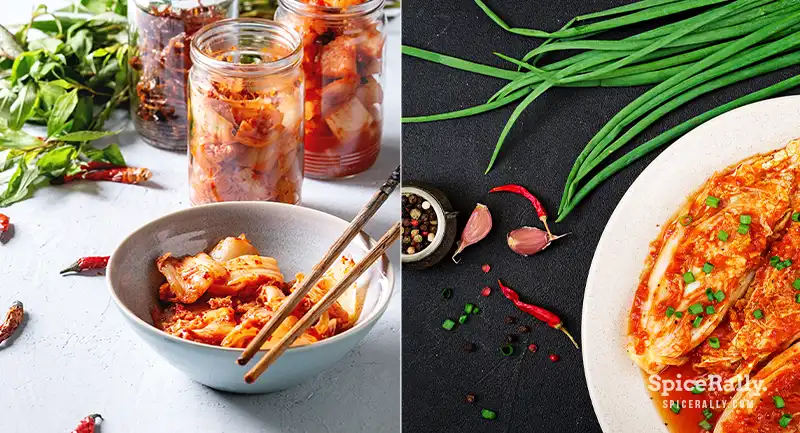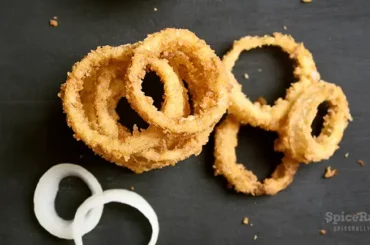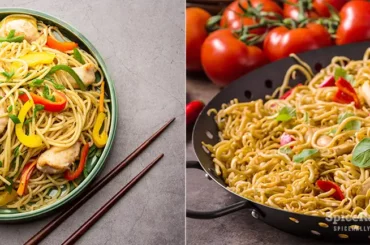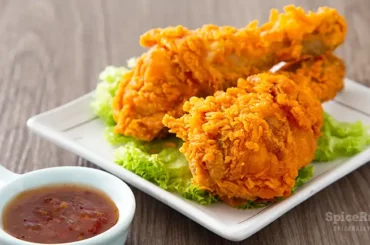The zesty and flavorful Korean national dish kimchi has won over many hearts of spicy food lovers all over the world. It is not just merely a major Korean staple but also one of the healthiest dishes on earth.
Traditional Korean kimchi is commonly enjoyed as a side dish and used as an ingredient when making certain main dishes. It is based on salted and fermented vegetables seasoned with garlic, ginger, fish sauce, etc., to give them diverse and complex flavors. We could find hundreds of different varieties of Kimchi.
We are so excited to share everything we know about this delectable Korean staple with you. So, keep reading until the end!
What Kimchi Really Is?
Kimchi is the national dish of Korea and a major staple in almost every Korean home, which always lies on the table either for breakfast, lunch, or dinner. This dish is basically fermented, salted vegetables and is often spicy and hot. It is commonly enjoyed as a condiment and is also incorporated into many dishes as an ingredient.
This dish is also treasured as one of the healthiest foods in the world, known for its nutritional value. We can find over two hundred varieties of kimchi made by fermenting different vegetables and seasoning them with various ingredients. These recipes might vary depending on the region, household, or personal preference.
Out of the hundreds of diverse kimchi types, the most popular versions include (we will elaborate on each type later in this post):
- Pogi kimchi
- Nabak kimchi
- Oi sobagi kimchi
- Chonggak kimchi
- Baek kimchi
- Gat kimchi
- Baechu-geotjeori kimchi
- Bossam kimchi
- Yeolmu kimchi
- Dongchimi
- Pa kimchi
- Buchu kimchi
- Kkakdugi
- Kkaennip Kimchi
The spiciness, hotness, and color of each of these kimchi types also vary depending on the recipe. But every kimchi dish is based on a fermented flavor note, giving this dish a unique taste to stand out from the rest of the foods.
Let’s Cast A Brief Look Into The History And Origin Of Kimchi…
The origin of kimchi dates about 3000-4000 years back into the ancient days of Korea. When the first Koreans began using agriculture, they had massive trouble with the weather because the winters were intensely cold.
Therefore, it was critical to saving food for the winter season since many were dying of starvation. So, the most famous way to preserve food was using salt on different kinds of crops and vegetables.
The first writings about kimchi emanate from the Goryeo Period. During this period, trade was demolished with other kingdoms, and new vegetables found their pathway to Korea, including Chinese or napa cabbage.
As a consequence, the method kimchi was prepared tends to evolve a lot. The authentic kimchi was made from radishes since this was a local crop. But over hundreds of years, new varieties of spices and vegetables were used to make different variations of the dish.
What Is Known As Gim-Jang or Kim-Jang?
Korean families gathered enough labor to prepare the hundreds of napa cabbages required to make sufficient kimchi for at least three months and up to a year. This village-conducted practice of creating and sharing kimchi is known as kim-jang or gim-jang.
Once all the ingredients were collected, the women would sit around to assemble kimchi. Different parties are accountable for each kimchi-making stage, such as washing, cutting, or brining the cabbages. This was also a joyful occasion where people would chat, gossip, and share. And often, it was where women were first taught how to make kimchi.
They store prepared kimchi in large earthenware fermentation vessels known as “onggi.” These containers are kept on the ground to stop freezing during the winter and to preserve them cool enough to delay the fermentation during the summer. These vessels are also kept outside in special terraces called “jangdokdae.” In 2013, UNESCO also acknowledged kim-jang as part of Korea’s Intangible Cultural Heritage.

What Is Kimchi Made Of? (Kimchi Ingredients)
Kimchi is a dish recognized for its veggie diversity. As a dish that is highly subjected to innovation and evolution, the ingredients tend to vary depending on the recipe. The most famous kimchi type is made using napa cabbage. And many commonly consumed varieties of this dish include a distinctive kimchi paste.
Vegetables, Fruits, And Greens Used In Kimchi
Koreans use a wide variety of traditional vegetables, greens, and even certain fruits when making their favorite national dish. The most popular vegetable used for kimchi-making is napa cabbage. In addition, they use the following greens, vegetables, and fruits:
- Daikon radish
- Chonggakmu (Korean ponytail radish)
- Yeolmu (summer radish)
- Cucumber
- Carrots
- Onions
- Buchu (Asian chives)
- Minari (water dropwort)
- Perilla leaves
- Korean pears
- Jujubes
- Chestnuts
- Pine nuts
- Green onions
- Apples
- Mustard greens
What Is Kimchi Paste?
Except for the kimchi dishes that appear in white, the majority are flavored with kimchi paste. In fact, your kimchi is just bland-tasting, salted vegetables or greens without this kimchi paste. This mixture typically comes together with ingredients such as:
- Gochugaru (Korean red pepper) powder or flakes
- Fish sauce
- Ginger
- Garlic
- Onion
- Sugar
- Salt
- Glutinous rice/ rice flour
- Rice vinegar
- Sesame seeds
The kimchi paste is the key to most kimchi dishes that lend all the spicy, hot, umami flavors along with the vibrant red color. Once this paste is made, it is slathered on vegetables, fruits, or greens, which are brined in salt water. This mixture can be made while you make kimchi or in advance. You’ll be able to buy this from the store, but many prefer making it at home.
Different Types Of Kimchi
As we mentioned earlier in this post, there are hundreds of different varieties of kimchi traditionally enjoyed in Korean households on a daily basis. But some types are popular in Korea and also recognized by international cuisines.
- Pogi kimchi– This can be considered the most basic kimchi type. This dish is made by fermenting napa cabbage and a few other vegetables like daikon, carrots, chives, etc., with the spicy kimchi paste.
- Nabak kimchi- This is made with napa cabbage, radish, and a few fruits like Korean pears and apples, fermented in a spicy, rose-colored brine.
- Oi sobagi kimchi- In this kimchi dish, crunchy small green cucumbers are fermented with carrots, chives, etc., and slathered with the kimchi paste.
- Chonggak kimchi– This delicious kimchi type is prepared by fermenting Korean ponytail radish with the kimchi paste.
- Baek kimchi– This kimchi is also known as “white kimchi” since it does not typically contain gochugaru. Baek kimchi is made with napa cabbage, radish, and a few other fruits and nuts, fermented in a white color brine.
- Gat Kimchi– This greens-based kimchi often comes together with mustard greens, apples, and green onions fermented with the kimchi paste.
- Baechu-geotjeori– Geotjeori is a special type of kimchi that is often eaten without fermenting. Instead, vegetables like napa cabbage, carrots, and green onions are slathered with the kimchi paste and eaten fresh.
- Bossam Kimchi– Thi simple kimchi dish comes together with Korean radish, Korean pears, and minari, fermented with the kimchi paste.
- Yeolmu Kimchi– Young summer radish is mixed with chile peppers and fermented in kimchi paste to make this dish.
- Dongchimi– This is another radish-based kimchi dish made along with pears and fermented in the kimchi paste.
- Pa kimchi- Pa kimchi comes together with green onions fermented in kimchi paste.
- Buchu Kimchi- In this kimchi dish, Asian chives and dried shrimp or anchovies are fermented with the zesty kimchi paste.
- Kkakdugi- This kimchi dish comes together with cubed daikon radish fermented with the traditional kimchi paste.
- Kkaennip Kimchi- Perilla leaves are slathered with the kimchi paste and fermented to make this kimchi dish.
Uses Of Kimchi
Why do you think kimchi became the national dish of Korea among all the other foods created in Korean cuisine? Yes, what you thought was absolutely right! It all comes down to its versatility as a condiment and ingredient. This popular Korean side dish also features in tons of other main dishes and can be used in the following ways:
- With rice dishes and rice bowls
- In savory pancakes and fritters
- In soup dishes
- To be mixed into dumpling stuffings
- To be incorporated into grilled cheese sandwiches
- It can be eaten with eggs
- To top off grain dishes
- Add into braises
- It can be added to pasta dishes
- The leftover kimchi liquid is used to flavor certain dishes
Kimchi Substitutes
The exotic flavor and how this dish makes us feel would be truly irreplaceable. But still, there could be times when you need kimchi so badly, but still can’t find it. Thus, here are some of the best substitutes you can use instead of kimchi:
- Sauerkraut
- Homemade kimchi
- Pickled vegetables
- Pickled jalapenos
- Miso paste
- Gochujang
- Malay pickle
Click on this link to discover how and when to use these substitutes for kimchi.
How Healthy Is Kimchi?
This dish is valued for its extensive nutritional value formed due to the process of lactic acid formation. In fact, kimchi is ranked as one of the healthiest dishes in the world for its many health benefits. It is low in calories and carbs, and it is excellent for your gut health. In addition, kimchi could give you the following health benefits:
- Strengthens the immune system
- Contain anti-aging properties
- Reduces inflammation
- It can be beneficial to heart health
- Promotes weight loss
- Prevents yeast infections
- It may contain anti-cancer properties
Is Kimchi Hot Or Spicy?
Kimchi can always be spicy but not hot. The hotness of this depends on how much gochugaru (red chile powder) you use. Nevertheless, most of the spiciness and heat comes from the kimchi paste, and sometimes kimchi dishes prepared with chile powder can be spicy due to the amount of garlic and ginger used.
Is Kimchi Gluten-Free?
Kimchi is generally gluten-free. However, this essentially depends on the ingredients used in preparing it. Therefore, your store-bought or homemade kimchi might have gluten in it.
Is Kimchi Vegan?
The inclusion of traditional seafood ingredients like fish sauce, shrimp, anchovies, etc., make kimchi an unfavorable addition to a vegan diet. However, vegan kimchi recipes exist that are made without fish sauce or any other animal traces.
Is Kimchi Keto-Friendly?
Kimchi is relatively low in carbs, making it an excellent pick for your diet if you are following a ketogenic diet. But make sure to check the nutrition label if you are buying kimchi from the store or inquire about the carbs from the server if you have this dish outside.
Kimchi Isn’t Merely A Side Dish!
Wholesome, flavorful, and vibrant kimchi is a dish worth trying at least once in your life! This exotic vegetable-based dish mostly comes together with traditional Korean flavors and is packed with tons of health benefits. There are over one hundred different varieties of different kimchi recipes, and they are made with a range of vegetables that are fermented with a zesty kimchi paste.




